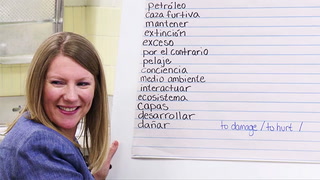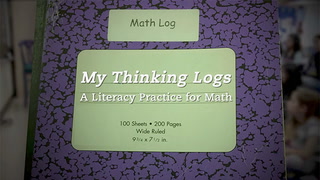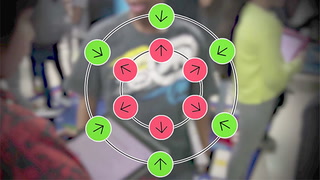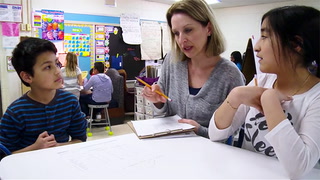Making Sense of Fractions Through Discourse Transcript
Chris: Are you guys ready for your math?
Whole class: Yes.
Chris: My name is Chris Carry, I'm a 5th grade dual language teacher at Banton Elementary in Waukesha, Wisconsin and I team teach with Jessica Hay.
Chris: We really want to see how much can we do mentally.
Chris: Our 2 way dual language in program in Waukesha starts at 4 year old kindergarten and goes all the way through 12th grade. The goal of our program is for our students to become bi-literate and bi-cultural. We have students who are strong in English, students who are strong in Spanish, and they build upon their strengths and get strong together.
Chris: So today we're going to start out with one of our number talks.
Chris: Today's math lesson was in English and we started with a number talk. Students where expected to come up with strategies for solving problems. And then that lead into our activity that had to do with multiplying and dividing fractions. The language learning target was, the students needed to be able to share their thinking, to verbalize it, and to follow directions in order to solve problems.
Chris: So in order to be able to do that mental math, we have to start looking for some what? Nidalia?
Nidalia: Efficient ways to do it?
Chris: Efficient ways to do it. Esme?
Esme: Patterns.
Chris: Patterns. We really want to see those patterns.
To get the students prepared so that they were able to tackle the challenging problem, we had to set the foundation for 'what does it mean to multiply and divide fractions, what does that look like?'.
What section of your math lab are these going to go in? Hector?
Hector. : Strategies.
Chris: Strategies. If you can't think of a strategy right away, is that okay? Yeah. So what are you going to have write in there, you just going to leave in blank? What are you going to write in there if you can't think of any strategies? Palem?
Palem: You might say I want to ask a question about it.
Chris: You might ask a question about it. Do you think when we come together and talk about it, your classmates may come up with some strategies that will help you? Yeah. So then you might start writing some things down. So those of you that are going over with Mrs. Hag, I'm gonna ask you to come and get one these and go right on over there and our group is gonna come on over here.
Chris: This is what you should have on your sheet. Tell me if I've mad a mistake. Do I ever make mistakes.
Whole class: Yes.
Chris: A number tack is great for all learners, but especially ELL's. Not only are they writing it and thinking it, but then they say it aloud and they get a chance to verbalize what it is that they're thinking and share with other people.
Chris: Okay I'm gonna give you three minutes, so it's really really quick, as fast as you can, what strategies do you notice as you're doing them. Go through, write them down. Think about what you're going to share.
Unnamed student: Can we use a multiplication chart?
Chris: That's a tool isn't it? Okay so you cut this into two parts right? You cut this into four parts, what do you think you're going to do to get this answer?
Unnamed student: So we have to divide?
Chris: Try it and see what happens.
Unnamed student: Multiply 44 times 8?
Chris: See what you get.
Unnamed student: Okay.
Chris: See what you get. Michelle what did you get for this, one half of 44?
Michelle: 22.
Chris: 22. I'm going to write this down. Give me a thumbs up or a thumbs down. Okay, how did you guys know that? You know it so quickly. How did you know that so quickly. Kiera?
Kiera: I knew it was 22 because I saw 44 and I saw the denominator which was 2, so it made me think that I need to cut it in half.
Chris: Now this one, what's the difference between this problem and this problem? What changed? Noami?
Noami: In the denominator, it's a 4 instead of a half.
Chris: So we know that we have to find a a 4 instead of a half, we know that our denominator has changed, great vocabulary. Is there somebody from Mrs. Hay's group that wants to share a strategy that they used when they were doing this? James?
James: I used the standard algorithm to solve the last problem and the second one.
Chris: Okay, I think that's what Tyler was telling us. So you multiplied across then divided by 12.
James: Mm-hmm (affirmative)
Chris: Okay.
So I'm going to read you a story that has to do with that Reece people. We're going to find out what they're doing. Are you ready?
We moved on from the number talk and went into a problem solving lesson where they had to determine the rate that people were running based on the time that it took them to run and the amount of laps that they ran. Okay, you're going to take one minute to look at it with yourselves, then I'm going to have you talk to you partner about what it is that you see and what it is that you notice and what do you think that information is giving you.
Unnamed student: I noticed that it shows the, like how many times they went around, circuits of track complete, and then it has like fractions and it has a number of miles that they each have.
Jessica.: Throughout the lessons students use their Ipads in order to personalize their instruction. They're able to draw or write or complete their assignments and then they can show their work to the class.
Chris: Alright, who wants to share. What did you notice when you were looking at this? Kiera?
Kiera: When you look at the minutes, Bob and Lilian I think, they don't have the minutes so you might need to be dividing it and multiplying.
Chris: So Kiera is already looking at some strategies. She's thinking she might have to divide.
On your ipad you're going to start taking some notes and you're going to try solving this. I'm only going to give you five minutes to work your bilingual partners because then we're going to put you in your big groups. So you have to move quickly. Okay? Ready, set, go.
When the students moved on to their problem solving, they first worked with their intentional partners. We tried to pair as much as we can in English dominance students with the Spanish dominance students so that they're always sharing.
Whole class: [crosstalk 00:06:12] Times 2 and that would be your product. And then times 3 and this would be it. Maybe this could help us to find the answers.
Or we could multiply 128 times 4 and see if we get [crosstalk 00:06:16]
No 120 divided by ... [crosstalk 00:06:19] Because I think if you multiplying, then you're gonna [crosstalk 00:06:24] Oh. Like I said in the classroom, in the whole group, we have to divide in the first one. So did you find any strategies that we could use? For trying to find out the rate [crosstalk 00:06:42] for the circuit, it looks like we have to multiply the minutes and seconds of track. [crosstalk 00:06:52]
Jessica.: Okay, here's what I'm going to ask you to do. We're gonna switch and get into our big groups. So, I'd like you to first move to get with your big group and then choose one person to get over and get one of your posters and one person to get supplies if you need to draw and write or anything like that.
When they go into their groups, we take their intentional pairs and then we put them into groups with the same strategy in mind. We make sure that there are students that may be stronger at certain things and students that may need a bit of support from their peers.
One thing I'm noticing is that some of you are ... Some of you got it, like yeah I know what to do, I'm not saying you're right, but you're going right to a strategy or going right to an algorithm. What's something that I might be wanting to see?
Unnamed student: Pictures?
Jessica.: Maybe you might want to show with a picture? Okay? Remember the other rule. Kiera?
Kiera: Everybody needs to join and participate.
Jessica.: Yes. Let's do it. Go.
Kiera: If you guys noticed, Ileen and Bob were the only ones that had rate, but didn't have minutes. So then we will have to do the opposite. That's what I think, I don't know about you guys, but so far that's what I'm guessing. [crosstalk 00:08:03]
Chris: How much of the track did she run? Chovani you can help me with this one. A half of the circuit right?
The advantage of co-teaching in a manner like this is that Jessica and I have a chance to bounce ideas off each other. We model that for our students when our students are working through a problem, because it comes naturally to us, that we need each other to make whatever it is that we're doing better.
How did you know that you were going to divide or multiply to get your answer here?
Whole class: [inaudible 00:08:43]
Kiera: Because ...
Chris: Your friends can jump in.
As we go around the room and check in with the kids, Jessica and I take notes. We then meet up later and talk about our notes and we talk about which of the students that maybe are having some misconceptions, we'll sometimes strategically pick students that we want to share their strategy later so that they can help their classmates get along to that point.
So do you see what I'm getting at? I'm trying to say, 'How did you know that you had to divide this by 4 to get your rate here?'.
Kiera: Um because if you do 4 times 30 you get 120.
Jessica.: But why? That's that hard part to explain. That's where have to push you out of your comfort zone. So how could you show this without just using the equations, the equations are going to get you answers some how, but first we get to that why. What can you do to help you?
Kiera: Draw a picture?
Jessica.: Mm-hmm (affirmative). A good picture might help. What would that picture maybe have in it?
Kiera: Race track?
Jessica.: Like a track. Okay, let's see if that will help.
Kiera: Like, maybe a number line. To see ... pretend it's one half, two halves, three halves, like that?
Jessica.: Okay, because right down here we're going to get into some fractions, right?
Kiera: Isn't it this way we have to divide, but going this way we need to multiply?
Jessica.: Yes.
Kiera: To get your answer. I know. 30 goes up here and 20 goes down here, right? Yeah.
Jessica.: I didn't expect the students to finish today, it's a challenging problem and it's one that I would rather have them take their time and get there and have some struggles along the way so that they have experience with persevering and finding answers. Tomorrow, they're going to need about 15 more minute to work in their groups.
How many of you are still really frustrated? Oh I think we have a few of us. Okay listen carefully for instructions. I'm going to ask you to put the posters back on the back table and we're going to finish those up tomorrow.
I think tomorrow when we look at the lesson, I'll look at somebody who has done a model and has done a picture and show how that can be helpful for the students who are not quite at that algorithm step, in solving the problem.
I heard some great math language. I heard some great math vocabulary coming out. Mrs. Hay and I are coming around and we're pushing you guys, because some of you guys were like 'I know how to do this, I've got it and I've got it' and we said show us. How are you going to show us? That's hard isn't it? So I appreciate it, you not saying 'ugh, forget it, I'm not going to do that.' You all stuck with it.
After the students worked in their groups, they had a sentence stem that said that 'This is what I learned and I know this because' and they have to expand upon that.
Once you have this, go ahead and start writing, 5 minutes when you feel like you're ready. Take a picture. Send it to me. Even if you're not sure, write down any kind of thinking that you might want to record right away.
Chris: Teaching in Waukesha in general is a great place because we're given permission to try new things and push ourselves out of our comfort zones which is hard to do as a teacher sometimes. So Banton in particular and the school district of Waukesha allows us to be okay with not being perfect and trying new things and that's what we expect of our students. So it's natural we should have to expect it of ourselves.
















1 Comment
John Ford Jun 23, 2022 10:36am
Teacher each had a group, bilingual partners, intentional partners, and gender partners
walking by asking why they made choices in discussions, question about finding strategies, questions to groups, and individual in a Group, and teacher notes
thumbs up thumbs down, iPad usage, student notes, and turn talk (think about information givef